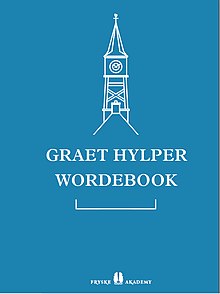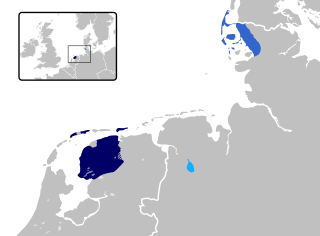
The Frisian languages are a closely related group of West Germanic languages, spoken by about 500,000 Frisian people, who live on the southern fringes of the North Sea in the Netherlands and Germany. The Frisian languages are the closest living language group to the Anglic languages; the two groups make up the Anglo-Frisian languages group and together with the Low German dialects these form the North Sea Germanic languages. However, modern English and Frisian are not mutually intelligible, nor are Frisian languages intelligible among themselves, owing to independent linguistic innovations and foreign influences.
The Frisians are an ethnic group indigenous to the coastal regions of the Netherlands and northwestern Germany. They inhabit an area known as Frisia and are concentrated in the Dutch provinces of Friesland and Groningen and, in Germany, East Frisia and North Frisia. The name is probably derived from frisselje. The Frisian languages are spoken by more than 500,000 people; West Frisian is officially recognised in the Netherlands, and North Frisian and Saterland Frisian are recognised as regional languages in Germany.
Northern Low Saxon is a subgroup of Low Saxon dialects of Low German. As such, it covers a great part of the West Low German-speaking areas of northern Germany, with the exception of the border regions where South Low Saxon is spoken, and Gronings dialect in the Netherlands.

Low German or Low Saxon is a West Germanic language variety spoken mainly in Northern Germany and the northeastern part of the Netherlands. The dialect of Plautdietsch is also spoken in the Russian Mennonite diaspora worldwide.

Stadsfries or Town Frisian is a set of dialects spoken in certain cities in the province of Friesland in the northern Netherlands, namely Leeuwarden, Sneek, Bolsward, Franeker, Dokkum, Harlingen, Stavoren, and to some extent in Heerenveen. For linguistic reasons, the outlying and insular dialects of Midsland (Terschelling), Ameland, Het Bildt, and Kollum are also sometimes tied to Stadsfries.

West Frisian, or simply Frisian, is a West Germanic language spoken mostly in the province of Friesland in the north of the Netherlands, mostly by those of Frisian ancestry. It is the most widely spoken of the Frisian languages.

Saterland Frisian, also known as Sater Frisian, Saterfrisian or Saterlandic, is the last living dialect of the East Frisian language. It is closely related to the other Frisian languages: North Frisian, spoken in Germany as well, and West Frisian, spoken in the Dutch province of Friesland.
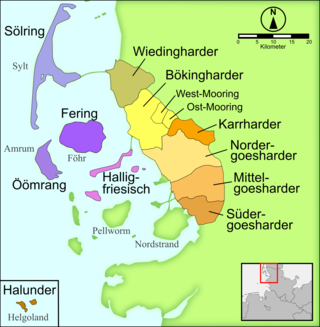
North Frisian is a minority language of Germany, spoken by about 10,000 people in North Frisia. The language is part of the larger group of the West Germanic Frisian languages. The language comprises 10 dialects which are themselves divided into an insular and a mainland group.

The Fryske Akademy, founded in 1938, is the scientific centre for research and education concerning Friesland and its people, language and culture, this in its broadest sense. The institution is based in the Coulonhûs and adjacent buildings in Leeuwarden. Together with several other institutes it belongs to the Royal Netherlands Academy of Arts and Sciences (KNAW). It has about 60 employees. In addition, some 300 scientists, amateurs and professionals, are active in the scientific societies hosted by the Fryske Akademy.
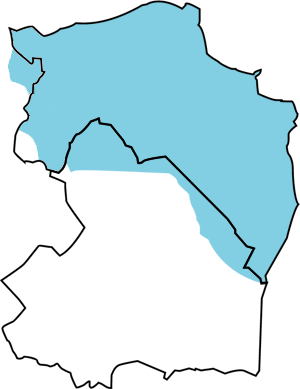
Gronings, is a collective name for some Friso-Saxon dialects spoken in the province of Groningen and around the Groningen border in Drenthe and Friesland. Gronings and the strongly related varieties in East Frisia have a strong East Frisian influence and take a remarkable position within West Low German. The dialect is characterized by a typical accent and vocabulary, which differ strongly from the other Low Saxon dialects.
Hollandic or Hollandish is the most widely spoken dialect of the Dutch language. Hollandic is among the Central Dutch dialects. Other important language varieties of spoken Low Franconian languages are Brabantian, Flemish, Zeelandic, Limburgish and Surinamese Dutch.
Frisian literature is works written in the Frisian languages, including that of West Frisian spoken in the province of Friesland in the Netherlands, from which most texts were produced or have survived. The first texts written in Frisian emerge around the 13th century.

Dutch, also known as Netherlandic or Netherlandish, is a West Germanic language spoken by about 25 million people as a first language and 5 million as a second language. It is the third most widely spoken Germanic language, after its close relatives German and English. Afrikaans is a separate but somewhat mutually intelligible daughter language spoken, to some degree, by at least 16 million people, mainly in South Africa and Namibia, evolving from the Cape Dutch dialects of Southern Africa. The dialects used in Belgium and in Suriname, meanwhile, are all guided by the Dutch Language Union.
The grammar of the West Frisian language, a West Germanic language spoken mostly in the province of Friesland (Fryslân) in the north of the Netherlands, is similar to other West Germanic languages, most notably Dutch. West Frisian is more analytic than its ancestor language Old Frisian, largely abandoning the latter's case system. It features two genders and inflects nouns in the singular and plural numbers.

Friso-Saxon is a group of West Germanic dialects found around the North Sea coast of the Netherlands and Germany, in an area historically known as Frisia. They are dialects of Low German/Low Saxon that have experienced strong influence from a Frisian language.
Rolf Hendrik Bremmer is a Dutch academic. He is professor of Old and Middle English, and extraordinary professor of Old Frisian, at Leiden University.

Flemish (Vlaams) is a Low Franconian dialect cluster of the Dutch language. It is sometimes referred to as Flemish Dutch, Belgian Dutch, or Southern Dutch. Flemish is native to the region known as Flanders in northern Belgium; it is spoken by Flemings, the dominant ethnic group of the region. Outside of Belgium Flanders, it is also spoken to some extent in French Flanders and the Dutch Zeelandic Flanders.

Justus Hiddes Halbertsma, West Frisian form: Joast Hiddes Halbertsma, pron. [jo.ǝst ˈhɪdəs ˈhɔlbǝtsma] ; Dutch form: Joost Hiddes Halbertsma, pron. [joːst ˈhɪdəs ˈhalbǝrtsma], was a Frisian writer, poet, minister, lexicographer and linguist. Today, he is primarily known for the poetry and short story collection De Lapekoer fan Gabe Skroar, which he wrote with his brother Eeltsje, publishing the first edition in 1822. Afterwards, this work was continually expanded, and also came to include contributions by a third brother, Tsjalling, until all the Halbertsma Brothers' prose and poetry was posthumously collected in 1871 to become the famous work Rimen en Teltsjes. Although the literary value of this collection was later disputed by some critics, it is undeniable that Rimen en Teltsjes played a role of crucial importance in the development of a new literary tradition after Western Frisian had been used almost exclusively as a spoken language for three centuries.
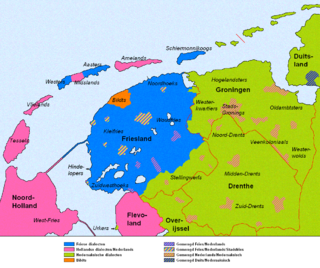
The West Frisian languages are a group of closely related, though not mutually intelligible, Frisian languages of the Netherlands. Due to the marginalization of all but mainland West Frisian, they are often portrayed as dialects of a single language.
Jan Geersing was a Dutch politician of the Reformed Political League and later Christian Union, who served as a member of the Friesland Parliament and as Mayor of Ferwerderadeel.
